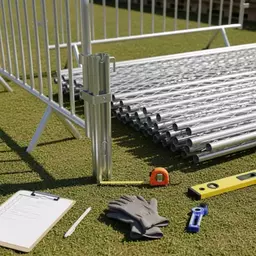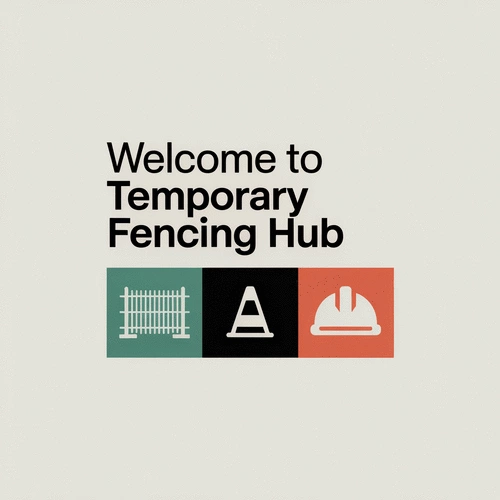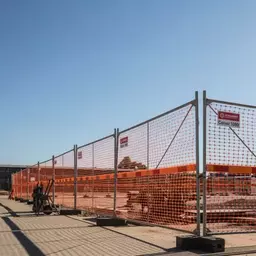Have you considered the crucial role that event fencing plays in ensuring safety at your gatherings? With the right knowledge and preparation, you can significantly enhance the experience for all attendees.
What You Will Learn
- The essential purpose of event fencing in managing crowd safety and compliance.
- Key Australian safety regulations like AS 4687 that every event organizer must follow.
- How to engage with local authorities and WorkSafe Australia for effective safety measures.
- Tips for creating a comprehensive event fencing checklist to ensure compliance and safety.
- The importance of planning for emergency exits and incident reporting as part of your event setup.
Event Fencing: Key Principles and Compliance
Understanding the essential guidelines for event fencing, including safety regulations, roles of governing bodies, and crucial planning steps, is vital for a successful and compliant event.
Safety Regulation Compliance
- ✓ Australian Standards AS 4687
- ✓ Local Government Regulations
- ✓ WorkSafe Australia Guidelines
Key Planning Steps
- ● Determine event size & layout
- ● Select appropriate materials
- ● Plan emergency access/exits
- ● Schedule safety inspections
Engaging Services & Reporting
- ★ Engage professional fencing services
- ★ Prepare for emergency exits
- ★ Establish incident reporting plans
Core Purpose of Event Fencing
- ► Manage crowd flow & control
- ► Enhance attendee safety
- ► Define event boundaries
Understanding Event Fencing in Australia: Safety and Compliance Essentials
In Australia, event fencing is a critical element for ensuring safety and compliance at various gatherings. Whether you're managing a local festival, a corporate function, or a large concert, the right temporary fencing can help manage crowds and create a secure environment. Understanding the importance of event fencing is essential for any organizer, as it impacts not just safety but also the overall experience of attendees.
Event fencing serves multiple purposes: it helps control access, protects attendees, and clearly defines boundaries. By utilizing proper fencing solutions, you can minimize risks and ensure that your event runs smoothly. At Temporary Fencing Hub, we aim to empower you with the knowledge to make informed decisions about your fencing needs.
What is Event Fencing and Why is it Important?
Event fencing refers to temporary barriers set up around an event venue to manage crowd flow and maintain safety. It’s important because it not only protects attendees from potential hazards but also assists in compliance with local regulations and safety standards. When executed correctly, event fencing enhances the overall experience of guests by providing a clear structure to the event.
- Enhances safety by directing crowd movement
- Provides visibility for security personnel
- Defines restricted areas such as backstage or VIP zones
As someone who has been in the temporary fencing industry for over a decade, I can attest that selecting the right fencing solution based on the type and size of your event is crucial. This ensures compliance and adds an extra layer of safety to your planning process.
Key Safety Regulations for Event Fencing in Australia
Safety regulations regarding event fencing in Australia are stringent, aimed at protecting both event organizers and attendees. It's vital to adhere to these regulations to avoid any legal repercussions and maintain a safe environment. Here are some key points to keep in mind:
- Understand Australian Standards AS 4687 for temporary fencing
- Comply with local government regulations specific to your event location
- Stay informed about your obligations under WorkSafe Australia guidelines
By understanding these regulations, you can effectively manage your event's safety protocols. I always encourage my clients to double-check compliance before the event to avoid any last-minute surprises!
Overview of Australian Standards AS 4687
The Australian Standards AS 4687 outlines the minimum requirements for temporary fencing and hoardings. This standard covers everything from structural integrity to installation methods. Following these guidelines helps ensure that your fencing withstands environmental factors while providing safety for attendees.
As event organizers, it’s essential to familiarize yourself with these standards. They not only assist in maintaining safety but also help in securing any necessary permits for your event.
Roles of WorkSafe Australia in Event Safety
WorkSafe Australia plays a crucial role in overseeing the safety standards for events. They provide guidance on safety practices and inspections to ensure compliance with national regulations. Engaging with WorkSafe can help event organizers understand their responsibilities and implement effective safety measures.
It's always a good practice to consult with local authorities or a safety expert to ensure that your event meets all compliance requirements. This proactive approach can save you time, money, and potential risks down the line!
Local Government Regulations for Event Fencing
Local governments often have specific regulations regarding temporary fencing for events, which can vary greatly from one municipality to another. It’s essential to reach out to your local council to understand any unique requirements for your event location.
- Check for zoning laws that may impact fencing placement
- Inquire about any necessary permits or inspections
- Understand noise regulations and crowd size limitations
As you navigate these regulations, remember that being informed and compliant is key to a successful event. My goal at Temporary Fencing Hub is to provide you with the resources you need to simplify this process. Let's make your event a safe and enjoyable experience together!
Pro Tip
When selecting your event fencing, consider not just the safety regulations but also the overall attendee experience. Utilizing fencing that allows for visibility can enhance security while still making your event feel inviting. Transparent mesh barriers are a great option, as they provide safety without obstructing views, helping to create a welcoming atmosphere for your guests.
Frequently Asked Questions about Event Fencing
What is the primary purpose of event fencing?
The primary purpose of event fencing is to manage crowd flow, enhance attendee safety, define event boundaries, and provide visibility for security personnel. It helps control access and delineate restricted areas, minimizing risks and ensuring smooth event operation.
Which Australian standards apply to event fencing?
Event fencing in Australia must comply with Australian Standards AS 4687, which outlines minimum requirements for temporary fencing and hoardings. Additionally, event organizers need to adhere to local government regulations and WorkSafe Australia guidelines.
How can I ensure my event fencing is compliant with local regulations?
To ensure compliance, you should contact your local council to understand specific requirements for your event location, including zoning laws and necessary permits. It's also advisable to consult with a safety expert or WorkSafe Australia for guidance.
Why is planning for emergency exits important in event fencing?
Planning for emergency exits is crucial for attendee safety. Clear and well-marked emergency paths ensure that people can exit quickly and safely in case of an incident. This is a key component of effective event setup and risk management.
What should an event fencing checklist include?
An event fencing checklist should include determining event size and layout, selecting appropriate fencing materials, researching local regulations and AS 4687 standards, engaging with WorkSafe Australia for advice, planning for emergency access and exits, and scheduling regular safety inspections.
Summary of Essential Guidelines for Event Fencing
As we wrap up our discussion on event fencing, it’s vital to highlight some key safety and compliance takeaways that every event organizer should keep in mind. Ensuring the safety of attendees starts with selecting the right type of fencing that meets local regulations and provides effective crowd control. Remember, a well-informed approach to fencing can significantly enhance the overall success of your event!
Furthermore, compliance with Australian Standards such as AS 4687 is not just a legal necessity but also a best practice that reinforces your commitment to safety. Engaging with local authorities and understanding the specific needs of your event can set you up for a seamless experience.
Recap of Key Safety and Compliance Takeaways
- Understand the importance of event fencing in maintaining safety and managing crowds.
- Always check and adhere to local safety regulations and guidelines.
- Utilize Australian Standards AS 4687 as a benchmark for compliance.
- Engage with WorkSafe Australia to ensure all safety measures are in place.
- Plan for accessibility in your fencing design for emergency situations, as highlighted by accessibility guidelines.
This list encapsulates the fundamentals that I, Simon Caldwell, have seen make a real difference in successful events. As someone who’s dedicated to providing expert guidance through Temporary Fencing Hub, I’ve witnessed the impact of thorough planning firsthand! Always remember that each event is unique, and adapting these guidelines is essential for ensuring safety and compliance.
Final Thoughts on Effective Event Setup and Management
In conclusion, effective event setup begins with meticulous planning and understanding your audience's needs. From choosing the right materials to setting up your temporary fencing, every detail counts! Engaging professional fencing services can ensure your event runs smoothly and safely.
Don’t forget to maintain open communication with your team and local authorities throughout the process. This collaborative approach not only fosters a safe environment but also enhances the overall experience for your attendees. Your proactive measures today will lead to successful events tomorrow!
Taking Action: Ensuring Your Event's Success
Creating Your Event Fencing Checklist for Compliance
To help streamline your planning, I recommend creating a comprehensive event fencing checklist. This checklist should cover all necessary compliance steps and safety features to ensure you don’t overlook any critical elements. Here’s a quick outline to get you started:
- Determine event size and layout.
- Select appropriate fencing materials.
- Research local regulations and AS 4687 standards.
- Engage with WorkSafe Australia for safety advice.
- Plan for emergency access and exits.
- Schedule regular safety inspections during the event.
This checklist serves as a foundation for your event planning. By following these steps, you can ensure that your fencing meets compliance standards and enhances safety. It's about being proactive in your planning to avoid issues down the line!
Next Steps for Engaging Professional Fencing Services
Once your checklist is in place, the next step is to consider engaging professional fencing services. With my experience at Temporary Fencing Hub, I can’t emphasize enough the value of working with experts who understand the nuances of local regulations and safety protocols. Here are some tips for finding the right service:
- Look for companies with a solid reputation in the event industry.
- Ask for references or case studies of previous events.
- Ensure they are knowledgeable about compliance and safety measures.
- Request detailed quotes that outline all services offered.
Choosing the right partner can alleviate a great deal of stress and ensure your event fencing is installed correctly and safely! Remember, investing in professional services pays off in the long run.
Preparing for Emergency Exits and Incident Reporting
Lastly, always prepare for the unexpected by prioritizing emergency exits and incident reporting plans. It’s essential to establish clear paths for attendees to exit safely in case of emergencies. Here’s how to approach this:
- Identify key areas where emergency exits are necessary.
- Clearly mark all exits with visible signage.
- Have a plan for reporting incidents quickly and efficiently.
- Conduct regular drills with your team to ensure everyone knows their roles.
By incorporating these preparations into your event planning, you’ll not only ensure compliance but also enhance the overall safety of your event. It’s about creating a secure environment where everyone can enjoy the festivities without worry!
Recap of Key Points
Here is a quick recap of the important points discussed in the article:
- Understand the importance of event fencing in maintaining safety and managing crowds.
- Always check and adhere to local safety regulations and guidelines.
- Utilize Australian Standards AS 4687 as a benchmark for compliance.
- Engage with WorkSafe Australia to ensure all safety measures are in place.
- Plan for accessibility in your fencing design for emergency situations.







